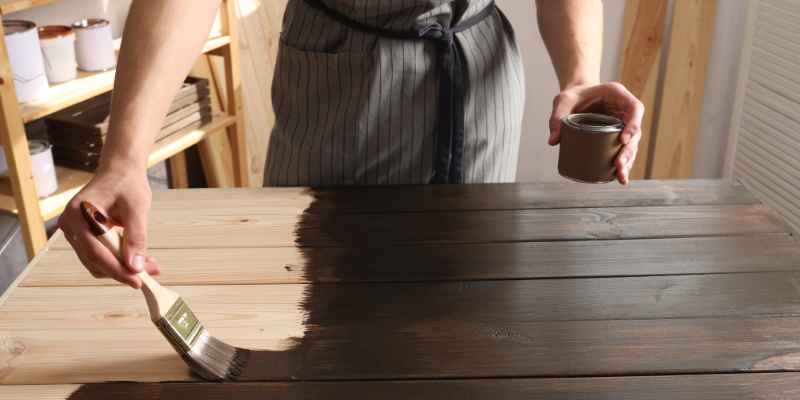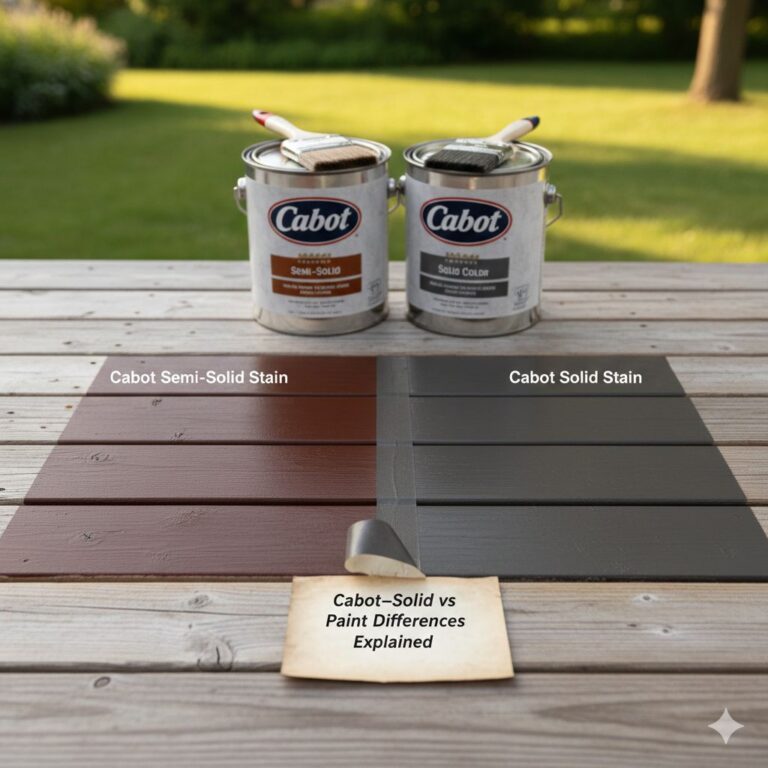Can I Apply Wood Conditioner After Stain: Myth-Busting Tips
Yes, you can apply wood conditioner after staining to enhance the finish and protect the wood. Wood conditioner helps seal the wood pores before applying stain, ensuring a more even color distribution and preventing blotchiness.
By following these steps, you can achieve a professional-looking and long-lasting finish for your wood projects. Applying wood conditioner after staining is a common practice among woodworkers to improve the overall appearance and durability of the wood surface. Whether you are working on furniture, cabinets, or other wooden items, using a wood conditioner can make a significant difference in the final outcome.
Let’s explore the benefits and proper application of wood conditioner after staining to elevate the quality of your woodworking projects.
The Role Of Wood Conditioner
When it comes to staining wood, it’s important to ensure that the wood is properly conditioned before applying the stain. Wood conditioner is a type of pre-stain treatment that helps to prepare the wood for staining, ensuring that it takes in the stain evenly and results in a smooth, professional-looking finish. In this blog post, we’ll take a closer look at the role of wood conditioner and answer the question: can I apply wood conditioner after stain?
Enhancing Wood Grain
One of the main benefits of using a wood conditioner is that it can help to enhance the natural grain of the wood. This is particularly important if you’re working with a type of wood that has a lot of natural variation in its grain, as the conditioner can help to bring out those variations and create a more beautiful, visually interesting finish. By conditioning the wood before staining, you’ll be able to achieve a more vibrant, textured look that will really make your project stand out.
Pre-stain Application Benefits
In addition to enhancing the wood grain, there are other benefits to using a wood conditioner before applying stain. For one thing, it can help to prevent the stain from being absorbed too deeply into the wood, which can result in a blotchy, uneven finish. Additionally, by sealing the wood with a conditioner before staining, you’ll be able to ensure that the stain goes on more evenly and smoothly, without any unsightly streaks or splotches. This can be especially important if you’re working with a particularly porous type of wood, as these tend to absorb stain more readily and can be more difficult to work with.
So, can you apply wood conditioner after stain? The short answer is no. Wood conditioner needs to be applied before staining, as it’s designed to help prepare the wood for the staining process. If you’ve already applied stain to your wood and are unhappy with the results, it may be possible to sand the stain off and start over with a fresh coat of conditioner and stain. However, it’s always best to apply the conditioner first to avoid any potential issues with the staining process.
In conclusion, if you want to achieve a beautiful, professional-looking finish on your woodworking project, using a wood conditioner before staining is essential. By enhancing the natural grain of the wood and ensuring that the stain goes on smoothly and evenly, you’ll be able to create a finished product that you can be proud of for years to come.
Common Staining Challenges

Applying wood conditioner after staining can pose common challenges. It is generally recommended to use wood conditioner before staining to ensure even absorption and prevent blotchiness. However, if needed, a light sanding can help improve adhesion for applying wood conditioner after staining.
Staining wood can be a rewarding and transformative process, enhancing the natural beauty of the grain and adding depth to your furniture or flooring. However, it is not without its challenges. Understanding and addressing these common staining challenges will help you achieve the desired results. In this section, we will explore two major issues that often arise during the staining process: uneven stain absorption and blotching and patchiness.
Uneven Stain Absorption
One of the most frustrating issues when staining wood is achieving an even absorption of the stain. Uneven stain absorption can result in areas of the wood appearing darker or lighter than desired, creating an inconsistent finish. This can be caused by various factors, such as the type of wood, its porosity, or the application technique.
To overcome this challenge, it is crucial to apply a wood conditioner before staining. Wood conditioner helps to seal the wood pores, ensuring an even absorption of the stain. By prepping the surface with a wood conditioner, you create a more uniform base for the stain to adhere to, minimizing the risk of uneven absorption.
Blotching And Patchiness
Blotching and patchiness occur when the stain is absorbed unevenly across the wood surface, resulting in dark spots or streaks. This issue is particularly common when staining softwoods, such as pine or spruce, as they have varying densities and absorb stain differently.
To prevent blotching and patchiness, it is essential to apply a pre-stain wood conditioner specifically designed to address this issue. These conditioners contain ingredients that help control the absorption of stain, minimizing the chances of blotching and ensuring a more consistent finish.
Additionally, adjusting your application technique can also help mitigate blotching and patchiness. Applying the stain in thin, even coats and wiping off any excess can help achieve a more uniform color. It is also crucial to follow the manufacturer’s instructions and allow sufficient drying time between coats.
By addressing these common staining challenges, you can achieve professional-looking results and enjoy the beauty of a well-stained wood surface. Remember to always test your staining process on a small, inconspicuous area before applying it to the entire piece to ensure the desired outcome.
Wood Conditioner And Stain: The Usual Sequence
Traditional Application Order
Applying wood conditioner after staining is not the conventional order. Traditionally, wood conditioner is applied before staining to prepare the wood for an even absorption of stain.
Purpose Of Pre-stain Conditioning
Pre-stain conditioning serves a vital purpose. It helps to prevent blotchiness and uneven color penetration in porous wood by promoting uniform stain absorption.
Rethinking Application: Conditioner After Stain
Yes, you can apply wood conditioner after stain to ensure the surface is properly sealed and protected. Applying conditioner after staining helps to enhance the wood’s natural beauty and prolong its lifespan. This extra step can result in a smoother finish and improved overall appearance.
Potential Advantages
Applying wood conditioner after stain may seem counterintuitive, but it can offer several potential advantages. By taking this unconventional approach, you can enhance the overall appearance and longevity of your stained wood surfaces.
One advantage is that applying conditioner after stain can help to even out the color and prevent blotchiness. Stains can sometimes penetrate unevenly, resulting in an inconsistent finish. However, by using a wood conditioner after stain, you can create a more uniform color distribution, giving your wood a smoother and more professional look.
Another advantage is that conditioner can help to improve the absorption and adhesion of the stain. Wood conditioners are designed to penetrate the wood fibers, opening up the pores and allowing the stain to better adhere to the surface. This can result in a more durable and long-lasting finish, protecting your wood from damage and wear.
Additionally, applying wood conditioner after stain can also help to enhance the overall richness and depth of the color. The conditioner can act as a sealant, trapping the stain within the wood and preventing it from fading or becoming dull over time. This can give your wood surfaces a vibrant and lustrous appearance that will last for years to come.
Risks And Considerations
While there are potential advantages to applying wood conditioner after stain, it is important to consider the risks and factors that may affect the outcome of this approach.
One risk is that the conditioner may not penetrate the stain effectively, leading to a less desirable finish. Stains are designed to soak into the wood, whereas conditioners typically form a protective barrier on the surface. Therefore, applying conditioner after stain may hinder the absorption and adhesion of the stain, resulting in a subpar finish.
Another consideration is the compatibility of the conditioner and stain. Not all wood conditioners and stains are compatible with each other, and using incompatible products can lead to issues such as peeling, cracking, or discoloration. It is crucial to carefully read the instructions and labels of both the conditioner and stain to ensure they can be used together effectively.
Furthermore, the order of application can also impact the overall outcome. Applying conditioner after stain may require additional steps or techniques to ensure proper adhesion and a smooth finish. It is essential to follow the manufacturer’s guidelines and recommendations to achieve the best results.
Overall, while applying wood conditioner after stain may have its potential advantages, it is important to carefully weigh the risks and considerations before deciding on this unconventional application method. By understanding the potential outcomes and taking the necessary precautions, you can achieve a beautiful and long-lasting finish for your stained wood surfaces.
Myth-busting: Separating Fact From Fiction

Common Misconceptions
One common misconception about wood finishing is that applying wood conditioner after stain is ineffective. However, this belief is not entirely accurate, and it’s important to separate fact from fiction to understand the truth behind this practice.
Expert Opinions And Evidence
Experts in woodworking and finishing have varied opinions on the topic. Some argue that applying wood conditioner after stain can still provide benefits, while others suggest that it may not be as effective as applying it before the stain. However, evidence shows that the outcome can depend on the specific wood type and the quality of the products used. It’s essential to consider these factors before making a decision.
Tips For Successful Wood Staining
To achieve successful wood staining, it is recommended to apply wood conditioner before the stain. This helps to even out the absorption of the stain, resulting in a more uniform and professional finish.
Choosing The Right Products
Ensure wood conditioner is compatible with the stain you plan to use.
Use high-quality wood conditioner and stain for best results.
Techniques For Even Application
- Apply wood conditioner evenly before stain for consistent results.
- Use a brush or cloth for smooth stain application.
- Avoid over-saturating the wood with stain for a uniform finish.
Fixing Staining Mistakes
Yes, you can apply wood conditioner after staining to ensure even absorption and a smoother finish. Applying the conditioner in the direction of the wood grain will help prevent streaking and blotching, resulting in a more uniform and professional-looking outcome.
Correcting Uneven Stain
If your stain application resulted in uneven color, applying wood conditioner can help. Simply re-stain the area to even out the color.
When To Sand And Restart
If the stain is not absorbing evenly, sanding the surface can help remove the excess stain. Then, reapply the stain for a fresh finish.
Maintaining And Protecting Stained Wood
When it comes to maintaining and protecting stained wood, applying wood conditioner after stain can be beneficial. This extra step helps to nourish and protect the wood, keeping it looking great for longer.
Ongoing Care Tips
Regularly dust stained wood surfaces to prevent buildup. Avoid using harsh cleaning products that can damage the stain. Apply furniture polish to keep the wood looking shiny.
Top Coats And Sealants
Consider adding a top coat or sealant to provide an extra layer of protection. Polyurethane, lacquer, or varnish can help seal in the stain and protect the wood from moisture and wear.
Frequently Asked Questions
Can Wood Conditioner Be Applied After Stain?
Yes, wood conditioner can be applied after stain. However, it’s important to allow the stain to fully dry before applying the conditioner. This helps the wood absorb the conditioner effectively, enhancing the final finish and protecting the wood surface.
What Is The Purpose Of Using Wood Conditioner?
Wood conditioner helps to prepare the wood for staining by promoting even absorption of the stain. It also minimizes blotching and enhances the overall finish of the wood. Applying wood conditioner before staining is particularly beneficial for softwoods and porous hardwoods.
Should I Sand Wood Before Applying Conditioner?
Yes, it’s recommended to sand the wood before applying conditioner. This helps to smooth the surface, remove imperfections, and open up the wood pores for better absorption of the conditioner. Proper sanding ensures that the wood is ready to receive the conditioner and stain effectively.
Can I Apply Multiple Coats Of Wood Conditioner?
It’s generally not necessary to apply multiple coats of wood conditioner. One even coat is usually sufficient to prepare the wood for staining. Applying excessive coats may lead to over-conditioning, affecting the absorption of the subsequent stain and the overall finish of the wood.
Conclusion
To sum up, applying wood conditioner after staining is not recommended. The primary reason being that wood conditioner is used to help the wood absorb the stain evenly. If you apply wood conditioner after staining, it may cause the stain to peel off or prevent the wood from absorbing the conditioner.
Therefore, it’s essential to follow the correct order of application to achieve the desired results. Remember to always read the manufacturer’s instructions and take necessary precautions before applying any product.







